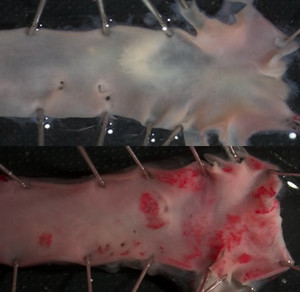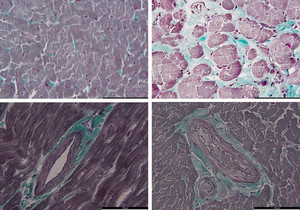"Every person -in every country in the world- should have the opportunity to live a long and healthy life."
(World Health Organization, www.who.int/health-topics/ageing)

The heart ages?
Particularly in view of the fact that the global population of people over 60 is expected to almost double to more than 2 billion by 2050 (World Health Organization), it is essential to ensure healthy aging and therapeutic measures for age-related diseases. All countries worldwide are increasingly faced with the challenge of preparing their health and social systems for this demographic shift and its associated consequences. In this context, the aging process represents a significant risk factor for the development of a wide range of diseases. In particular, aging is accompanied by profound changes in the cardiovascular system: At the cellular level, changes in mitochondria, the energy power plants of the cells, accumulation of free oxygen radicals, and increasing inflammatory processes accompanied by a limited repair capacity of the cells become apparent during the course of life. At the organ level, hypertrophy of the heart tissue and increased accumulation of connective tissue both in the heart (so-called myocardial fibrosis) and in the large vessels can be found, as well as the development of arteriosclerotic plaques and a deterioration of cardiac function. These mechanisms, in complex interactions also with other organs, lead to the clinically visible pictures of hypertension, coronary heart disease, myocardial infarction and heart failure. Therefore, a significant increase in cardiovascular diseases can be expected, especially from the 5th decade of life. Research into and elucidation of these mechanisms and underlying causes, as well as their treatment and prevention, are essential to adequately counter the predicted massive increase in cardiovascular diseases, especially in the elderly population.
Which animal model for what?
In biomedical research, various animal models are available to test research questions in the cardiological field. In particular, rodent species and pigs are currently used to study molecular and functional mechanisms of cardiac pathologies, to test new surgical methods and therapeutic options, or to identify potential biomarkers for cardiovascular diseases. Although a lot of essential information can be obtained in these ways, various differences between animal species and the genetic distance to humans in some areas limit the translation of obtained knowledge to the human situation.
The use of non-human primate species opens up new possibilities here: Particularly short-lived species such as the common marmoset (Callithrix jacchus, 300-500g, average age 12 years) show the first natural signs of aging such as cartilage defects, hearing loss and nerve cell degeneration already at the age of a few years. In addition, it is known from colony studies that they can develop obesity and diabetes comparable to humans.
What is it about?
As part of the research focus "Cardiovascular Aging", our department is investigating and characterizing the common marmoset as a potential animal model for age-associated cardiovascular changes as a first step. Molecular biological investigations are used in an interdisciplinary project funded by the German Center for Cardiovascular Research e.V. (Deutsches Zentrum für Herz-Kreislauf-Forschung e.V.) together with functional cardiac catheterizations and non-invasive imaging techniques to collect physiological data for the species common marmoset. In cooperation with internal and external colleagues, additional organs will also be examined for signs of aging. In a second step, biomarkers and possible human-relevant therapeutic targets for the occurring changes will be identified before these can be tested in the future using disease models.
Images of a joint cooperation project with the Max Planck Institute for Multidisciplinary Natural Sciences, Translational Molecular Imaging Group (Head: Prof. Frauke Alves): Shown are sections from the heart tissue of common marmosets visualized by multiphoton microscopy. In different areas (top row: Heart tissue, middle row: Vascular areas, bottom row: Heart surface), different tissue types can be visualized using this imaging technique. In superimposed images (right column), connective tissue thus becomes visible in white (taken from Khan et al. Label-free imaging of age-related cardiac structural changes in non-human primates using multiphoton nonlinear microscopy, Biomed Opt Express. 2021 Nov 1; 12(11): 7009-7023).
Cooperations
Extern:
Medizinische Hochschule Hannover: Prof. Thomas Thum
https://www.mhh.de/institute-zentren-forschungseinrichtungen/imtts
Institut für Pharmakologie und Toxikologie - Universitätsmedizin Göttingen : Priv-Doz. Dr. rer. nat. Laura Zelarayan
http://www.pharmacology.med.uni-goettingen.de/AG_Zelarayan.html
Max-Planck-Institut für Neurobiologie des Verhaltens – caesar: Dr. Silke Haverkamp
https://mpinb.mpg.de/en/research-groups/groups/computational-neuroethology/members.html
Max-Planck-Institut für Multidisziplinäre Naturwissenschaften, Arbeitsgruppe Translationale Molekulare Bildgebung: Prof. Frauke Alves
https://www.mpinat.mpg.de/de/alves
Universitätsmedizin Göttingen Institut für Neuroanatomie: Prof. Jochen Staiger
http://www.neuroanatomie.uni-goettingen.de/de/staff/1-jochen-staiger
Intern:
Abteilung Funktionelle Bildgebung
https://www.dpz.eu/de/abteilung/funktionelle-bildgebung/ueber-uns.html
Forschungsplattform Degenerative Erkrankungen
https://www.dpz.eu/de/platformen/degenerative-erkrankungen/ueber-uns.html
Abteilung Primatengenetik
https://www.dpz.eu/de/abteilung/primatengenetik/ueber-uns.html






